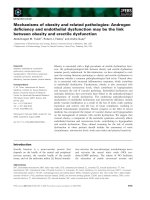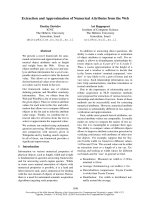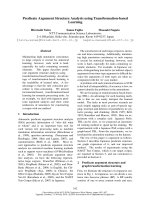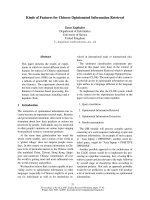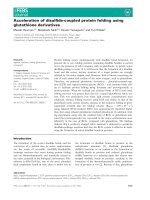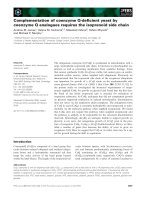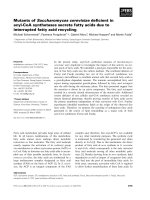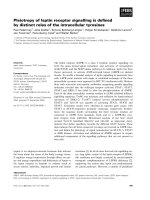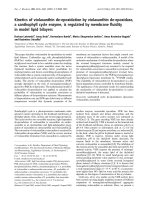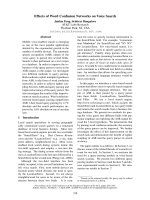Báo cáo khoa học: "Extraction of definitions using grammar-enhanced machine learning" pdf
Bạn đang xem bản rút gọn của tài liệu. Xem và tải ngay bản đầy đủ của tài liệu tại đây (92.16 KB, 9 trang )
Proceedings of the EACL 2009 Student Research Workshop, pages 88–96,
Athens, Greece, 2 April 2009.
c
2009 Association for Computational Linguistics
Extraction of definitions using grammar-enhanced machine learning
Eline Westerhout
Utrecht University
Trans 10, 3512 JK, Utrecht, The Netherlands
Abstract
In this paper we compare different ap-
proaches to extract definitions of four
types using a combination of a rule-based
grammar and machine learning. We col-
lected a Dutch text corpus containing 549
definitions and applied a grammar on it.
Machine learning was then applied to im-
prove the results obtained with the gram-
mar. Two machine learning experiments
were carried out. In the first experi-
ment, a standard classifier and a classi-
fier designed specifically to deal with im-
balanced datasets are compared. The al-
gorithm designed specifically to deal with
imbalanced datasets for most types outper-
forms the standard classifier. In the second
experiment we show that classification re-
sults improve when information on defini-
tion structure is included.
1 Introduction
Definition extraction can be relevant in differ-
ent areas. It is most times used in the do-
main of question answering to answer ‘What-is’-
questions. The context in which we apply defini-
tion extraction is the automatic creation of glos-
saries within elearning. This is a new area and
provides its own requirements to the task. Glos-
saries can play an important role within this do-
main since they support the learner in decoding
the learning object he is confronted with and in
understanding the central concepts which are be-
ing conveyed in the learning material.
Different approaches for the detection of def-
initions can be distinguished. We use a sequen-
tial combination of a rule-based approach and ma-
chine learning to extract definitions. As a first step
a grammar is used and thereafter, machine learn-
ing techniques are applied to filter the incorrectly
extracted data.
Our approach has different innovative aspects
compared to other research in the area of defini-
tion extraction. The first aspect is that we address
less common definition patterns also. Second, we
compared a common classification algorithm with
an algorithm designed specifically to deal with im-
balanced datasets (experiment 1), which seems to
be more appropriate for us because we have some
data sets in which the proportion of “yes”-cases is
extremely low. A third innovative aspect is that
we examined the influence of the type of gram-
mar used in the first step (sophisticated or basic)
on the final machine learning results (experiment
1). The sophisticated grammar aims at getting the
best balance between precision and recall whereas
the basic grammar only focuses at getting a high
recall. We investigated to which extent machine
learning can improve the low precision obtained
with the basic grammar while keeping the recall
as high as possible and then compare the results
to the performance of the sophisticated grammar
in combination with machine learning. As a last
point, we investigated the influence of definition
structure on the classification results (experiment
2). We expect this information to be especially
useful when a basic grammar is used in the first
step, because the patterns matched with such a
grammar can have very diverse structures.
The paper is organized as follows. Section 2 in-
troduces some relevant work in definition extrac-
tion. Section 3 explains the data used in the experi-
ments and the definition categories we distinguish.
Section 4 discusses the way in which grammars
have been applied to extract definitions and the
results obtained with them. Section 5 then talks
about the machine learning approach, covering is-
sues such as the classifiers, the features and the ex-
periments. Section 6 and section 7 report and dis-
cuss the results obtained in the experiments. Sec-
tion 8 provides the conclusions and presents some
future work.
88
2 Related research
Research on the detection of definitions has been
pursued in the context of automatic building of
dictionaries from text, question-answering and re-
cently also within ontology learning.
In the area of automatic glossary creation, the
DEFINDER system combines shallow natural lan-
guage processing with deep grammatical analysis
to identify and extract definitions and the terms
they define from on-line consumer health litera-
ture (Muresan and Klavans, 2002). Their approach
relies entirely on manually crafted patterns. An
important difference with our approach is that they
start with the concept and then search for a defini-
tion of it, whereas in our approach we search for
complete definitions.
A lot of research on definition extraction has
been pursued in the area of question-answering,
where the answers to ‘What is’-questions usually
are definitions of concepts. In this area, they most
times start with a known concept (extracted from
the question) and then search the corpus for snip-
pets or sentences explaining the meaning of this
concept. The texts used are often well structured,
which is not the case in our approach where any
text can be used. Research in this area initially
relied almost totally on pattern identification and
extraction (cf. (Tjong Kim Sang et al., 2005)) and
only later, machine learning techniques have been
employed (cf. (Blair-Goldensohn et al., 2004;
Fahmi and Bouma, 2006; Miliaraki and Androut-
sopoulos, 2004)).
Fahmi and Bouma (2006) combine pattern
matching and machine learning. First, candidate
definitions which consist of a subject, a copular
verb and a predicative phrase are extracted from a
fully parsed text using syntactic properties. There-
after, machine learning methods are applied on the
set of candidate definitions to distinguish defini-
tions from non-definitions; to this end a combina-
tion of attributes has been exploited which refer to
text properties, document properties, and syntac-
tic properties of the sentences. They show that the
application of standard machine learning meth-
ods for classification tasks (Naive Bayes, SVM
and RBF) considerably improves the accuracy of
definition extraction based only on syntactic pat-
terns. However, they only applied their approach
on the most common definition type, that are the
definitions with a copular verb. In our approach
we also distinguish other, less common definition
types. Because the patterns of the other types
are more often also observed in non-definitions,
the precision with a rule-based approach will be
lower. As a consequence, the dataset for machine
learning will be less balanced. In our approach
we applied – besides a standard classification al-
gorithm (Naive Bayes) – also a classification al-
gorithm designed specifically to deal with imbal-
anced datasets.
In the domain of automatic glossary creation,
Kobylinski and Przepi´orkowski (2008) describe
an approach in which a machine learning algo-
rithm specifically developed to deal with imbal-
anced datasets is used to extract definitions from
Polish texts. They compared the results obtained
with this approach to results obtained on the same
data in which hand crafted grammars were used
(Przepi´orkowski et al., 2007) and to results with
standard classifiers (Deg´orski et al., 2008). The
best results were obtained with their new ap-
proach. The differences with our approach are
that (1) they use either only machine learning or
only a grammar and not a combination of the two
and (2) they do not distinguish different defini-
tion types. The advantage of using a combina-
tion of a grammar and machine learning, is that
the dataset on which machine learning needs to be
applied is much smaller and less imbalanced. A
second advantage of applying a grammar first, is
that the grammar can be used to add information
to the candidate definitions which can be used in
the machine learning features. Besides, applying
the grammar first, gives us the opportunity to sep-
arate the four definition types.
3 Definitions
Definitions are expected to contain at least three
parts. The definiendum is the element that is de-
fined (Latin: that which is to be defined). The
definiens provides the meaning of the definiendum
(Latin: that which is doing the defining). Definien-
dum and definiens are connected by a verb or
punctuation mark, the connector, which indicates
the relation between definiendum and definiens
(Walter and Pinkal, 2006).
To be able to write grammar rules we first ex-
tracted 549 definitions manually from 45 Dutch
text documents. Those documents consisted of
manuals and texts on computing (e.g. Word, La-
tex) and descriptive documents on academic skills
and elearning. All of them could be relevant learn-
89
Type Example sentence
to be Gnuplot is een programma om grafieken te maken
‘Gnuplot is a program for drawing graphs’
verb E-learning omvat hulpmiddelen en toepassingen die via het internet beschikbaar zijn en creatieve mogeli-
jkheden bieden om de leerervaring te verbeteren .
‘eLearning comprises resources and application that are available via the Internet and provide creative
possibilities to improve the learning experience’
punctuation Passen: plastic kaarten voorzien van een magnetische strip, die door een gleuf gehaald worden, waardoor
de gebruiker zich kan identificeren en toegang krijgt tot bepaalde faciliteiten.
‘Passes: plastic cards equipped with a magnetic strip, that can be swiped through a card reader, by means
of which the identity of the user can be verified and the user gets access to certain facilities. ’
pronoun Dedicated readers. Dit zijn speciale apparaten, ontwikkeld met het exclusieve doel e-boeken te kunnen
lezen.
‘Dedicated readers. These are special devices, developed with the exclusive goal to make it possible to read
e-books.’
Table 1: Examples for each of the definition types.
ing objects in an elearning enivronment and are
thus representative for the glossary creation con-
text in which we will use definition extraction.
Based on the connectors used in the found pat-
terns, four common definition types were distin-
guished. The first type are the definitions in which
a form of the verb to be is used as connector. The
second group consists of definitions in which a
verb (or verbal phrase) other than to be is used as
connector (e.g. to mean, to comprise). It also hap-
pens that a punctuation character is used as con-
nector (mainly :), such patterns are contained in
the third type. The fourth category contains the
definitory contexts in which relative or demonstra-
tive pronouns are used to point back to a defined
term that is mentioned in a preceding sentence.
The definition of the term then follows after the
pronoun. Table 1 shows an example for each of
the four types. To be able to test the grammar on
unseen data, the definition corpus was split in a
development and a test part. Table 2 shows some
general statistics of the corpus.
Development Test Total
# documents 33 12 45
# words 286091 95722 381813
# definitions 409 140 549
Table 2: General statistics of the definition corpus.
4 Using a grammar
To extract definition patterns two grammars have
been written on the basis of 409 manually selected
definitions from the development corpus. The
XML transducer lxtransduce developed by Tobin
(2005) is used to match the grammars against files
in XML format. Lxtransduce is an XML trans-
ducer that supplies a format for the development
of grammars which are matched against either
pure text or XML documents. The grammars are
XML documents which conform to a DTD (lx-
transduce.dtd, which is part of the software).
The grammars consist of four parts. In the first
part, part-of-speech information is used to make
rules for matching separate words. The second
part consists of rules to match chunks (e.g. noun
phrases, prepositional phrases). We did not use
a chunker, because we want to be able to put re-
strictions on the chunks. For example, to match
the definiendum, we only want to select relatively
simple NPs (mainly of the pattern (Article) - (Ad-
jective) - Noun(s)). The third part contains rules
for matching and marking definiendums and con-
nectors. In the last part the pieces are put together
and the complete definition patterns are matched.
The rules were made as general as possible to pre-
vent overfitting to the corpus.
Two types of grammars have been used: a basic
grammar and a sophisticated grammar. With the
basic grammar, the goal is to obtain a high recall
without bothering too much about precision. The
number of rules for detecting the patterns is 26 of
which 6 fall in the first category (matching words),
15 fall in the third part (matching parts of defi-
nitions) and 5 fall in the fourth category (match-
ing complete definitions). There are no rules of
the second category in this grammar (matching
chunks), because the focus is on the connector pat-
terns only and not on the pattern of the definien-
dum and definiens. In the sophisticated grammar
the aim is to design rules in such a way that a high
recall is obtained while at the same time the pre-
cision does not become very low. This grammar
contains 40 rules, which is 14 more than contained
in the basic grammar. There are 12 rules in part 1,
90
5 in part 2, 11 rules in the third part and 12 rules
in the last part.
The first difference between the basic and the
sophisticated grammar is thus the number of rules.
However, the main difference is that the basic
grammar puts fewer restrictions on the patterns.
Restrictions on phrases present in the sophisti-
cated grammar such as ‘the definiendum should be
an NP of a certain structure’ are not present in the
basic grammar. For example, to detect is patterns,
the basic grammar simply marks all words before
a form of to be as definiendum and the complete
sentence containing a form of to be as definition.
(Westerhout and Monachesi, 2007) describes the
design of the sophisticated grammar and the re-
sults obtained with it in more detail.
Table 3 shows that the recall is always higher
with the basic grammar is considerably, which is
what you would expect because fewer restrictions
are used. The consequence of using a less strict
grammar is that the precision decreases. The gain
of recall is much smaller than the loss in precision,
and therefore the f-score is also lower when the
basic grammar is used.
type corpus precision recall f-measure
is SG 0.25 0.82 0.38
BG 0.03 0.98 0.06
verb SG 0.29 0.71 0.41
BG 0.08 0.81 0.15
punct SG 0.04 0.67 0.08
BG 0.01 0.97 0.02
pron SG 0.05 0.47 0.10
BG 0.03 0.66 0.06
all SG 0.13 0.70 0.22
BG 0.03 0.86 0.06
Table 3: Results with sophisticated grammar (SG)
and basic grammar (BG) on the complete corpus.
5 Machine learning
The second step is aimed at improving the preci-
sion obtained with the grammars, while trying to
keep the recall as high as possible. The sentences
extracted with the grammars are input for this step
(table 3). We thus have two datasets: the first
dataset contains sentences extracted with the ba-
sic grammar and the second dataset contains sen-
tences extracted with the sophisticated grammar.
Because the datasets are relatively small, both de-
velopment and test results have been included to
get as much training data as possible. As a con-
sequence of using the output of the grammars as
dataset, the definitions not detected by the gram-
mar are lost already and cannot be retrieved any-
more. So, for example, the overall recall for the is
type where the sophisticated grammar is used as a
first step can not become more than 0.82.
The first classifier used is the Naive Bayes clas-
sifier, a common algorithm for text classification
tasks. However, because some of our datasets
are quite imbalanced and have an extremely low
percentage of correct definitions, the Naive Bayes
classifier did not always perform very well. There-
fore, a balanced classifier has been used also for
classifying the data. After describing the classi-
fiers, the experiments and the features used within
the experiments are discussed.
5.1 Classifiers
5.1.1 Naive Bayes classifier
The Naive Bayes classifier has often been used
in text classification tasks (Lewis, 1998; Mitchell,
1997; Fahmi and Bouma, 2006). Because of the
relatively small size of our dataset and sparse-
ness of the feature vector, the calculated numbers
of occurrences were very small and we expected
them to provide no additional information to the
classifier. For this reason, we used supervised
discretization (instead of normal distribution), in
which numeric attributes are converted to nominal
ones, and in this way removed the information on
the number of times n-grams occurred in a partic-
ular sentence.
5.1.2 Balanced Random Forest classifier
The Naive Bayes (NB) classifier is aimed at get-
ting the best possible overall accuracy and is there-
fore not the best method when dealing with imbal-
anced data sets. In our experiments, all datasets
are more or less imbalanced and consist of a mi-
nority part with definitions and a majority part
with non-definitions. The extent to which the
dataset is imbalanced differs depending on the
type and the grammar that has been applied. Table
4 shows for each type the proportion that consti-
tutes the minority class with definitions. As can
be seen from this table, the sets for is and verb
definitions obtained with the sophisticated gram-
mar are the most balanced sets, whereas the others
are heavily imbalanced.
The problem of heavily imbalanced data can
be addressed in different ways. The approach we
adopted consists in a modification of the Random
91
SG (%) BG (%)
is 24.6 3.0
verb 28.9 8.1
punct 4.8 1.0
pron 5.4 2.9
Table 4: Percentage of correct definitions in sen-
tences extracted with sophisticated (SG) and basic
(BG) grammar.
Forest classifier (RF; (Breiman, 2001)). In Bal-
anced Random Forest (BRF; (Chen et al., 2004)),
for each decision tree two bootstrapped sets of the
same size, equal to the size of the minority class,
are constructed: one for the minority class, the
other for the majority class. Jointly, these two sets
constitute the training set. In our experiments we
made 100 trees in which at each node from 20
randomly selected features out of the total set of
features the best feature was selected. The final
classifier is the ensemble of the 100 trees and de-
cisions are reached by simple voting. We expect
the BRF classifier to outperform the NB classifier,
especially on the less balanced types.
5.2 Experiments
Two experiments have been conducted. Because
the datasets are relatively small 10-fold cross val-
idation has been used in all experiments for better
reliability of the classifier results.
5.2.1 Comparing classifier types
In the first experiment, the Naive Bayes and the
Balanced Random Forest classifiers are compared,
both on the data obtained with the sophisticated
and basic grammar. As features n-grams of the
part-of-speech tags were used with n being 1, 2
and 3. The main purpose of this experiment is to
compare the performance of the two classifiers to
see which method performs best on our data. We
expect the advantage of using the BRF method to
be bigger when the datasets are more imbalanced,
since the BRF classifier has been designed specifi-
cally to deal with imbalanced datasets. The second
purpose of the experiment is to investigate whether
combining a basic grammar with machine learning
can give better results than a sophisticated gram-
mar combined with machine learning. Because the
datasets will be more imbalanced for each type
when the basic grammar is used, we expect the
BRF method to perform better than the NB classi-
fier on the definition class. However, the counter
effect of using the balanced method will be that the
scores on the non-definition class will be worse.
5.2.2 Influence of definition structure
In the second experiment, we investigated whether
the structure of a definition provides informa-
tion that helps when classifying instances for the
datasets created with the basic grammar. As
features the part-of-speech tag n-grams of the
definiendum, the first part-of-speech tag n-gram
of the definiens and the part-of-speech tag n-
grams of the complete sentence. Because we have
seen when developing the sophisticated grammar
that the structure of the definiendum is very im-
portant for distinguishing definitions from non-
definitions, we decided to add information on the
structure of this part in the features of the data ob-
tained with the basic grammar. Also the first part
of the definiens often seemed to have a comparable
structure, therefore we included this part as well in
our features. We expect that including this infor-
mation will result in a better classification result.
6 Results
6.1 Comparing classifier types
Table 5 shows the results of the different classi-
fiers. When we look at the results for the sophis-
ticated grammar, we see that for the less balanced
datasets (i.e. the punct and pron types) the BRF
classifier outperforms the NB classifier. For these
two types there were no definitions classified cor-
rectly and as a consequence both the precision and
the recall are 0. For the other two types the re-
sults of the different classifiers are comparable.
When the classifiers are used after the basic gram-
mar has been applied, the recall is substantially
better for all four types when the BRF method is
used. However, the precision is quite low with
this approach, mainly due to the low scores for
the punct and pron types. The accuracy of the re-
sults, that is, the over all proportion of correctly
classified instances, is in all cases higher when
the Naive Bayes classifier is used. This is due
to the fact that the number of misclassified non-
definition sentences is higher when the BRF clas-
sifier is used.
Table 6 shows a comparison of the final results
obtained with the sophisticated grammar and the
basic grammar in combination with the two ma-
chine learning algorithms. The performance varies
largely per type and the overall score is highly in-
fluenced by the is and verb type, which together
92
Naive Bayes
Sophisticated grammar Basic grammar
precision recall f-measure accuracy precision recall f-measure accuracy
is 0.82 0.76 0.79 0.90 0.26 0.66 0.38 0.93
verb
0.77 0.75 0.76 0.86 0.67 0.17 0.27 0.93
punct
0 0 0 0.95 0 0 0 0.98
pron
0.36 0.30 0.33 0.93 0 0 0 0.97
all
0.72 0.61 0.66 0.92 0.29 0.32 0.31 0.95
Balanced Random Forest
Sophisticated grammar Basic grammar
precision recall f-measure accuracy precision recall f-measure accuracy
is 0.77 0.79 0.78 0.89 0.18 0.82 0.30 0.88
verb
0.76 0.78 0.77 0.87 0.29 0.65 0.40 0.84
punct
0.13 0.61 0.22 0.79 0.06 0.61 0.10 0.79
pron
0.18 0.62 0.28 0.83 0.08 0.41 0.13 0.83
all
0.43 0.74 0.55 0.84 0.15 0.68 0.24 0.85
Table 5: Performance of Naive Bayes classifier and Balanced Random Forest classifier on the results
obtained with the grammars.
contain 69.8 % of the definitions. For the other
two types, the BRF classifier performs consider-
ably better, independent of which grammar has
been used in the first step. The overall f-measure
is best when the sophisticated grammar is used,
where the recall is higher with the BRF classifier
and the precision is better with the NB classifier.
Naive Bayes
grammar precision recall f-measure
is SG 0.82 0.62 0.70
BG 0.26 0.65 0.37
verb SG 0.77 0.53 0.63
BG 0.67 0.14 0.23
punct SG 0 0 0
BG 0 0 0
pron SG 0.36 0.14 0.20
BG 0 0 0
all SG 0.72 0.43 0.54
BG 0.29 0.27 0.28
Balanced Random Forest
grammar precision recall f-measure
is SG 0.77 0.65 0.70
BG 0.18 0.80 0.30
verb SG 0.76 0.55 0.64
BG 0.29 0.53 0.37
punct SG 0.13 0.42 0.20
BG 0.06 0.52 0.10
pron SG 0.18 0.29 0.22
BG 0.08 0.27 0.12
all SG 0.43 0.52 0.47
BG 0.15 0.57 0.24
Table 6: Final results of sophisticated grammar
(SG) and basic grammar (BG) in combination with
Naive Bayes classifier and Balanced Random For-
est classifier.
6.2 Influence of definition structure
Table 7 shows the results obtained with the BRF
classifier on the sentences extracted with the ba-
sic grammar when sentence structure is taken into
account. When we compare these results to ta-
ble 5, we see that the overall recall is higher when
structural information is provided to the classifier.
However, to which extent the structural informa-
tion contributes to a correct classification of the
definitions is different per type and also depends
on the amount of structural information provided.
When only information on the definiendum and
first part of the definiens are included, the pre-
cision scores are lower than the results obtained
with n-grams of the complete sentence. Providing
all information, that is, information on definien-
dum, first part of the definiens and the complete
sentence, gives the best results.
All information
precision recall f-measure accuracy
is 0.24 0.82 0.38 0.92
verb 0.29 0.81 0.43 0.82
punct 0.04 0.84 0.08 0.58
pron 0.09 0.54 0.16 0.83
all 0.14 0.78 0.24 0.82
Definiendum and first n-gram of definiens
precision recall f-measure accuracy
is 0.19 0.82 0.31 0.89
verb 0.25 0.78 0.38 0.80
punct 0.03 0.96 0.05 0.23
pron 0.05 0.57 0.09 0.65
all 0.09 0.78 0.16 0.71
Table 7: Performance of Balanced Random Forest
classifier with information on sentence structure in
features applied on the results obtained with the
basic grammar.
For the is type, the recall remains the same
when structural information is added and the pre-
cision increases, especially when all structural in-
93
formation is used. Information on the structure of
the definiens and the first n-gram of the definiens
thus improves the classification results for this
type.
The recall of verb definitions is higher when
structural information is used whereas the preci-
sion does not change. The fact that the precision is
hardly influenced by adding structural information
might be explained by the fact that connectors and
connector phrases are quite diverse for this type.
As a consequence, different types of first n-grams
of the definiens might be used and the predicting
quality of structural information is smaller.
The classification of the punct patterns is quite
different depending on the amount of structural in-
formation used. The recall increases when struc-
tural information is added, whereas the precision
decreases. Adding structural information thus re-
sults in a low accuracy, especially when only the
n-grams of the definiendum and the first n-gram of
the definiens are used. For this type of patterns the
structure of the complete definition is thus impor-
tant for obtaining a reasonable precision.
For the pronoun patterns the recall is higher
when structural information is included. The pre-
cision is slightly higher when all structural infor-
mation is included, but remarkably lower when
only the n-grams of the definiendum and the first
n-gram of the definiens are used. From this we can
conclude that for this pattern type information on
the structure of the complete definition is crucial
to get a reasonable precision.
7 Evaluation and discussion
Which classifier performs best depends on the bal-
ance of the corpus. For the more balanced datasets
the results of the NB and the BRF method are al-
most the same. The more imbalanced the corpus,
the bigger the difference between the two meth-
ods, where BRF outperforms the NB classifier.
The accuracy is in all cases higher when the NB
classifier is used, due to the fact that this classi-
fier scores better on the majority part with non-
definitions. The inevitable counter effect of using
the BRF method is that the scores on this part are
lower, because the two classes now get the same
weight.
The answer to the question which grammar
should be used in the first step can be viewed from
different perspectives, by looking either at the goal
or the definition type.
When aiming at getting the highest possible re-
call, the BRF method in combination with the ba-
sic grammar gives the best overall results. How-
ever, when using these settings, the precision is
quite low. When the goal is to obtain the best
balance between recall and precision, this might
therefore not be the best choice. In this case, the
best option would be to use a combination of the
sophisticated grammar and the BRF method, in
which the recall is slightly lower than when the
basic grammar is used, but the precision is much
higher.
We can also view the question which gram-
mar should be used from a different perspective,
namely by looking at the definition type. To get
the best result for each of the separate types, we
would need to use different approaches for the dif-
ferent types. When the BRF method is used, for
two types the recall is considerably higher when
the basic grammar is used, whereas for the other
two types the recall scores are comparable for the
two grammars. However, again this goes with a
lower precision score, and therefore this may not
be the favourable solution in a practical applica-
tion. So, also when looking at a per type basis, us-
ing the sophisticated grammar seems to be the best
option when the aim is to get the best balance.
We are now able to answer the questions ad-
dressed in the first experiment and summarize
our conclusions on which classifier and grammar
should be used in table 8. The conclusions are
based on the final results obtained after both the
grammar and machine learning have been applied
(table 6). Although the recall is very important,
because of the context in which we want to apply
definition extraction the precision also cannot be
too low. In a practical application a user would
not like it to get 5 or 6 incorrect sentences for each
correct definition.
Best recall Best balance
is BG + BRF SG + NB / BRF
verb SG + NB / BRF SG + NB / BRF
punct BG + BRF SG + BRF
pron SG / BG + BRF SG + BRF
Table 8: Best combination of grammar and classi-
fier when aiming at best recall or best balance.
Information on structure in all cases results in
a higher number of correctly classified definitions.
The recall for the definition class is for all types
remarkably higher when only the n-grams of the
94
definiendum and the first n-gram of the definiens
are considered. However, this goes with a much
lower precision and f-score and might therefore
not be the best option. When using all informa-
tion, the best results are obtained: the recall goes
up while the precision and f-score do not change
considerably. However, although the results are
improved, they are still lower then the results ob-
tained with the sophisticated grammar.
A question that might rise when looking at the
results for the different types, is whether the punc-
tuation and pronoun patterns should be included
when building an application for extracting defini-
tions. Although these types are present in texts –
they make up 30 % of the total number of defini-
tions – and can be extracted with our methods, the
results are poor compared to the results obtained
for the other two types. Especially the bad preci-
sion for these types gives reasons to have a closer
look at these patterns to discover the reason for
these low scores. The bad results might be caused
by the amount of training data, which might be too
low. Another reason might be that the patterns are
more diverse than the patterns of the other types,
and therefore more difficult to detect.
It is difficult to compare our results to other
work on definition extraction, because we are the
only who distinguish different types. However, we
try to compare research conducted by Fahmi and
Bouma (2006) on the first pattern and Kobyli´nski
and Przepi´orkowski (2008) on definitions in gen-
eral. Fahmi and Bouma (2006) combined a rule-
based approach and machine learning for the de-
tection of is definitions in Wikipedia articles. Al-
though they used more structured texts, the accu-
racy they obtained is the same as the accuracy we
obtained in our experiments. However, they did
not report precision, recall, and f-score for the def-
inition class separately, which makes it difficult
to compare their result to ours. Kobyli´nski and
Przepi´orkowski (2008) applied machine learning
on unstructured texts using a balanced classifier
and obtained a precision of 0.21, a recall of 0.69
and an f-score of 0.33 with an overall accuracy of
0.85. These scores are comparable to the scores
we obtained with the basic grammar in combina-
tion with the BRF classifier. Using the sophisti-
cated grammar in combination with BRF outper-
forms the results they obtained. From this we can
conclude that using a sophisticated grammar has
advantages over using machine learning only.
8 Conclusions and future work
On the basis of the results we can draw some con-
clusions. First, the type of grammar used in the
first step influences the final results. With the fea-
tures and classifiers used in our approach, the so-
phisticated grammar gives the best results for all
types. The added value of a sophisticated gram-
mar is also confirmed by the fact that the results
Kobyli´nski and Przepi´orkowski (2008) obtained
without using a grammar are lower then our re-
sults with the sophisticated grammar. A second
lesson learned is that it is useful to distinguish dif-
ferent definition types. As the results vary depend-
ing on which type has to be extracted, adapting
the approach to the type to be extracted will re-
sult in a better overall performance. Third, the de-
gree to which the dataset is imbalanced influences
the choice for a classifier, where the BRF performs
better on less balanced datasets. As there are many
other NLP problems in which there is an interest-
ing minority class, the BRF method might be ap-
plied to those problems also. From the second ex-
periment, we can conclude that taking definition
structure into account helps to get better classifi-
cation results. This information has not been im-
plemented in other approaches yet and other work
on definition extraction can thus profit from this
new insight.
The results obtained so far clearly indicate that
a combination of a rule-based approach and ma-
chine learning is a good way to extract defini-
tions from texts. However, there is still room for
improvement, and we will work on this in the
next months. In near future, we will investigate
whether our results improve when more linguistic
information is added in the features. Especially
for the basic grammar, we expect it to be possi-
ble to get a better recall when more information
is added. We can make use of the grammar rules
implemented in the sophisticated grammar to see
there which information might be relevant. To im-
prove the precision scores obtained with the so-
phisticated grammar, we will also look at linguis-
tic information that might be relevant. However,
improving this score using linguistic information
will be more difficult, because the grammar al-
ready filtered out a lot of incorrect patterns. To
improve results obtained with this grammar, we
will therefore look at different features, such as
features based on document structure, keywordi-
ness of definiendum and similarity measures.
95
References
S. Blair-Goldensohn, K. R. McKeown, and
A. Hazen Schlaikjer, 2004. New Directions In
Question Answering, chapter Answering Defini-
tional Questions: A Hybrid Approach. AAAI
Press.
L. Breiman. 2001. Random Forests. Machine Learn-
ing, 46:5–42.
C. Chen, A. Liaw, and L. Breiman. 2004. Using ran-
dom forest to learn imbalanced data. Technical Re-
port 666, University of California, Berkeley.
Ł. Deg´orski, M. Marci´nczuk, and A. Przepi´orkowski.
2008. Definition extraction using a sequential com-
bination of baseline grammars and machine learning
classifiers. In Proceedings of the Sixth International
Conference on Language Resources and Evaluation,
LREC 2008.
I. Fahmi and G. Bouma. 2006. Learning to iden-
tify definitions using syntactic features. In R. Basili
and A. Moschitti, editors, Proceedings of the EACL
workshop on Learning Structured Information in
Natural Language Applications.
Ł. Kobyli´nski and A. Przepi´orkowski. 2008. Defi-
nition extraction with balanced random forests. In
B. Nordstr¨om and A. Ranta, editors, Advances in
Natural Language Processing: Proceedings of the
6th International Conference on Natural Language
Processing, GoTAL 2008, pages 237–247. Springer
Verlag, LNAI series 5221.
D. D. Lewis. 1998. Naive (Bayes) at forty: The in-
dependence assumption in information retrieval. In
Claire N´edellec and C´eline Rouveirol, editors, Pro-
ceedings of ECML-98, 10th European Conference
on Machine Learning, number 1398, pages 4–15,
Chemnitz, DE. Springer Verlag, Heidelberg, DE.
S. Miliaraki and I. Androutsopoulos. 2004. Learn-
ing to identify single-snippet answers to definition
questions. In Proceedings of COLING 2004, pages
1360–1366.
T. M. Mitchell. 1997. Machine learning. McGraw-
Hill.
S. Muresan and J. Klavans. 2002. A method for au-
tomatically building and evaluating dictionary re-
sources. In Proceedings of the Language Resources
and Evaluation Conference (LREC 2002).
A. Przepi´orkowski, Ł. Deg´orski, M. Spousta,
K. Simov, P. Osenova, L. Lemnitzer, V. Kubon,
and B. W´ojtowicz. 2007. Towards the automatic
extraction of denitions in Slavic. In Proceedings of
BSNLP workshop at ACL.
E. Tjong Kim Sang, G. Bouma, and M. de Rijke. 2005.
Developing offline strategies for answering medical
questions. In D. Moll´a and J. L. Vicedo, editors,
Proceedings AAAI 2005 Workshop on Question An-
swering in Restricted Domains.
R. Tobin. 2005. Lxtransduce, a replace-
ment for fsgmatch. http://www.
ltg.ed.ac.uk/
˜
richard/ltxml2/
lxtransduce-manual.html.
S. Walter and M. Pinkal. 2006. Automatic extraction
of definitions from German court decisions. In Pro-
ceedings of the workshop on information extraction
beyond the document, pages 20–28.
E. N. Westerhout and P. Monachesi. 2007. Extraction
of Dutch definitory contexts for elearning purposes.
In Proceedings of CLIN 2006.
96
